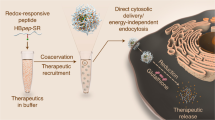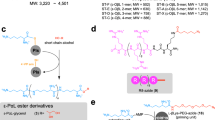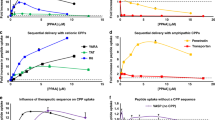Abstract
Listeriolysin O (LLO), a sulfhydryl-activated pore-forming protein from Listeria monocytogenes, was tested and utilized for promoting plasmid DNA (pDNA) delivery into the cytosol of cells in culture. To render pDNA-complexing capability to LLO, the unique cysteine 484 of LLO was conjugated to polycationic peptide protamine (PN) at a 1:1 molar ratio through a reversible, endosome-labile disulfide bond. The sulfhydryl-oxidized LLO construct, LLO-s-s-PN, completely lacked its pore-forming activity, yet regained its original activity upon reduction. The enhanced cytosolic delivery using this construct therefore relies on the requisite reduction of the disulfide bond in LLO-s-s-PN by endogenous cellular reducing capacity. Condensed PN/pDNA complexes incorporating LLO-s-s-PN were tested for their enhanced gene delivery capability monitoring reporter gene expression in HEK293, RAW264.7, P388D1 cell lines and bone-marrow-derived macrophages in the presence of serum. Dramatic enhancement was observed for all tested complexes with varying weight ratios. The effect was most prominent at 0.64–0.80 (w/w) of PN/pDNA upon replacing 1–4% of PN with LLO-s-s-PN, resulting in approximately three orders of magnitude higher luciferase expression compared to PN/pDNA without apparent toxicity. These results demonstrate that incorporation of endosomolytic LLO into pDNA delivery systems in a controlled fashion is a promising approach of enhancing delivery into the cytosol of target cells in gene delivery strategies.
This is a preview of subscription content, access via your institution
Access options
Subscribe to this journal
Receive 12 print issues and online access
$259.00 per year
only $21.58 per issue
Buy this article
- Purchase on Springer Link
- Instant access to full article PDF
Prices may be subject to local taxes which are calculated during checkout






Similar content being viewed by others
References
Wagner E et al. Transferrin–polycation conjugates as carriers for DNA uptake into cells. Proc Natl Acad Sci USA 1990; 87: 3410–3414.
Wu GY, Wu CH . Receptor-mediated gene delivery and expression in vivo. J Biol Chem 1988; 263: 14 621–14 624.
Boussif O et al. A versatile vector for gene and oligonucleotide transfer into cells in culture and in vivo: polyethylenimine. Proc Natl Acad Sci USA 1995; 92: 7297–7301.
Lee RJ, Huang L . Folate-targeted, anionic liposome-entrapped polylysine-condensed DNA for tumor cell-specific gene transfer. J Biol Chem 1996; 271: 8481–8487.
Gao X, Huang L . Potentiation of cationic liposome-mediated gene delivery by polycations. Biochemistry (Mosc) 1996; 35: 1027–1036.
Zauner W, Wagner E, Ogris M . Polylysine-based transfection systems utilizing receptor-mediated delivery. Adv Drug Deliv Rev 1998; 30: 97–113.
Wagner E . Application of membrane-active peptides for nonviral gene delivery. Adv Drug Deliv Rev 1999; 38: 279–289.
Wagner E et al. Influenza virus hemagglutinin HA-2 N-terminal fusogenic peptides augment gene transfer by transferring–polylysine–DNA complexes: toward a synthetic virus-like gene-transfer vehicle. Proc Natl Acad Sci USA 1992; 89: 7934–7938.
Wagner E et al. Coupling of adenovirus to transferring–polylysine/DNA complexes greatly enhances receptor-mediated gene delivery and expression of transfected genes. Proc Natl Acad Sci USA 1992; 89: 6099–6103.
Wyman TB et al. Design, synthesis, and characterization of a cationic peptide that binds to nucleic acids and permeabilizes bilayers. Biochemistry 1997; 36: 3008–3017.
Legendre JY, Szoka Jr. FC . Cyclic amphipathic peptide–DNA complexes mediate high-efficiency transfection of adherent mammalian cells. Proc Natl Acad Sci USA 1993; 90: 893–897.
Nishikawa M et al. Hepatocyte-targeted in vivo gene expression by intravenous injection of plasmid DNA complexed with synthetic multi-functional gene delivery system. Gene Ther 2000; 7: 548–555.
Finlay BB, Cossart P . Exploitation of mammalian host cell functions by bacterial pathogens. Science 1997; 276: 718–725.
Dietrich G et al. Delivery of antigen-encoding plasmid DNA into the cytosol of macrophages by attenuated suicide Listeria monocytogenes. Nat Biotechnol 1998; 16: 181–185.
Sizemore DR, Branstrom AA, Sadoff JC . Attenuated Shigella as a DNA delivery vehicle for DNA-mediated immunization. Science 1995; 270: 299–302.
Darji A et al. Oral somatic transgene vaccination using attenuated S. typhimurium. Cell 1997; 91: 765–775.
Smith AE . Viral vectors in gene therapy. Annu Rev Microbiol 1995; 49: 807–838.
Jacobs T, Darji A, Weiss S, Chakraborty T . In: Alouf JE, Freer JH (eds), The Comprehensive Sourcebook of Bacterial Protein Toxins. Academic Press: London, 1999, pp 511–521.
Portnoy DA, Jones S . The cell biology of Listeria monocytogenes infection (escape from a vacuole). Ann N Y Acad Sci 1994; 730: 15–25.
Gottschalk S, Tweten RK, Smith LC, Woo SL . Efficient gene delivery and expression in mammalian cells using DNA coupled with perfringolysin O. Gene Ther 1995; 2: 498–503.
Alouf JE, Geoffroy C . In: Alouf JE, Freer JH (eds), Sourcebook of Bacterial Protein Toxins. Academic Press: London, 1991, pp 147–186.
Cowell JL, Grushoff-Kosyk PS, Bernheimer AW . Purification of cereolysin and the electrophoretic separation of the active (reduced) and inactive (oxidized) forms of the purified toxin. Infect Immun 1976; 14: 144–154.
Iwamoto M, Ohno-Iwashita Y, Ando S . Role of the essential thiol group in the thiol-activated cytolysin from Clostridium perfringens. Eur J Biochem 1987; 167: 425–430.
Lee KD, Oh YK, Portnoy DA, Swanson JA . Delivery of macromolecules into cytosol using liposomes containing hemolysin from Listeria monocytogenes. J Biol Chem 1996; 271: 7249–7252.
Mandal M, Lee KD, . Listeriolysin O-liposome-mediated cytosotic delivery of macromolecule antigen in vivo: enhancement of antigen-specific cytotoxic T lymphocyte frequency, activity and tumor protectionListeria monocytogenes. Biochim Biophys Acta 2002; 1563: 7–17.
Mandal M, Lee KD . Listeriolysin O-liposome-mediated cytosotic delivery of macromolecule antigen in vivo: enhancement of antigen-specific cytotoxic T lymphocyte frequency, activity and tumor protection. Biochim Biophys Acta 2002; 1563: 7–17.
Ando T, Yamasaki M, Suzuki K . Protamines. Isolation, characterization, structure and function. Mol Biol Biochem Biophys 1973; 12: 1–114.
Sorgi FL, Bhattacharya S, Huang L . Protamine sulfate enhances lipid-mediated gene transfer. Gene Ther 1997; 4: 961–968.
Yang JP, Huang L . Overcoming the inhibitory effect of serum on lipofection by increasing the charge ratio of cationic liposome to DNA. Gene Ther 1997; 4: 950–960.
Perales JC et al. Biochemical and functional characterization of DNA complexes capable of targeting genes to hepatocytes via the asialoglycoprotein receptor. J Biol Chem 1997; 272: 7398–7407.
Sekiya K, Danbara H, Futaesaku Y . [Mechanism of pore formation on erythrocyte membrane by streptolysin-O]. Kansenshogaku Zasshi 1993; 67: 736–740.
Beauregard KE, Lee KD, Collier RJ, Swanson JA . pH-dependent perforation of macrophage phagosomes by listeriolysin O from Listeria monocytogenes. J Exp Med 1997; 186: 1159–1163.
Portnoy DA, Tweten RK, Kehoe M, Bielecki J . Capacity of listeriolysin O, streptolysin O, and perfringolysin O to mediate growth of Bacillus subtilis within mammalian cells. Infect Immun 1992; 60: 2710–2717.
Geoffroy C, Gaillard JL, Alouf JE, Berche P . Purification, characterization, and toxicity of the sulfhydryl-activated hemolysin listeriolysin O from Listeria monocytogenes. Infect Immun 1987; 55: 1641–1646.
Feener EP, Shen WC, Ryser HJ . Cleavage of disulfide bonds in endocytosed macromolecules. A processing not associated with lysosomes or endosomes. J Biol Chem 1990; 265: 18 780–18 785.
Shen WC, Ryser HJ, LaManna L . Disulfide spacer between methotrexate and poly(D-lysine). A probe for exploring the reductive process in endocytosis. J Biol Chem 1985; 260: 10 905–10 908.
Papini E, Rappuoli R, Murgia M, Montecucco C . Cell penetration of diphtheria toxin. Reduction of the interchain disulfide bridge is the rate-limiting step of translocation in the cytosol. J Biol Chem 1993; 268: 1567–1574.
Ryser HJ, Mandel R, Ghani F . Cell surface sulfhydryls are required for the cytotoxicity of diphtheria toxin but not of ricin in Chinese hamster ovary cells. J Biol Chem 1991; 266: 18 439–18 442.
Mandel R et al. Inhibition of a reductive function of the plasma membrane by bacitracin and antibodies against protein disulfide-isomerase. Proc Natl Acad Sci USA 1993; 90: 4112–4116.
Maric M et al. Defective antigen processing in GILT-free mice. Science 2001; 294: 1361–1365.
Phan UT, Arunachalam B, Cresswell P . Gamma-interferon-inducible lysosomal thiol reductase (GILT). Maturation, activity, and mechanism of action. J Biol Chem 2000; 275: 25 907–25 914.
Luster AD, Weinshank RL, Feinman R, Ravetch JV . Molecular and biochemical characterization of a novel gamma-interferon-inducible protein. J Biol Chem 1988; 263: 12 036–12 043.
Gainey D, Short S, McCoy KL . Intracellular location of cysteine transport activity correlates with productive processing of antigen disulfide. J Cell Physiol 1996; 168: 248–254.
Merkel BJ, Mandel R, Ryser HJ, McCoy KL . Characterization of fibroblasts with a unique defect in processing antigens with disulfide bonds. J Immunol 1995; 154: 128–136.
Zychlinsky A, Prevost MC, Sansonetti PJ . Shigella flexneri induces apoptosis in infected macrophages. Nature 1992; 358: 167–169.
Tsang AW, Oestergaard K, Myers JT, Swanson JA . Altered membrane trafficking in activated bone marrow-derived macrophages. J Leukoc Biol 2000; 68: 487–494.
Gedde MM, Higgins DE, Tilney LG, Portnoy DA . Role of listeriolysin O in cell-to-cell spread of Listeria monocytogenes. Infect Immun 2000; 68: 999–1003.
Glomski IJ et al. The Listeria monocytogenes hemolysin has an acidic pH optimum to compartmentalize activity and prevent damage to infected host cells. J Cell Biol 2002; 156: 1029–1038.
Connor J, Schroit AJ . Transbilayer movement of phosphatidylserine in erythrocytes: inhibition of transport and preferential labeling of a 31000-dalton protein by sulfhydryl reactive reagents. Biochemistry 1988; 27: 848–851.
Gusse M et al. Purification and characterization of nuclear basic proteins of human sperm. Biochim Biophys Acta 1986; 884: 124–134.
Portnoy DA, Jacks PS, Hinrichs DJ . Role of hemolysin for the intracellular growth of Listeria monocytogenes. J Exp Med 1988; 167: 1459–1471.
Racoosin EL, Swanson JA . Macropinosome maturation and fusion with tubular lysosomes in macrophages. J Cell Biol 1993; 121: 1011–1020.
Acknowledgements
We thank Dr Daniel Portnoy (UC Berkeley) for the LLO-his plasmid and Dr Gary Nabel (National Institutes of Health) for the GFP-luciferase plasmid. We thank Dr Joel Swanson (University of Michigan) and members of the Lee and Amidon Labs for helpful discussions. G Saito was supported by a fund from Sankyo Co. Ltd (Tokyo, Japan). This work was supported by NIH grants R29AI42084 and R01AI47173, and Rackham Fund and Vahlteich Research Fund at the University of Michigan.
Author information
Authors and Affiliations
Rights and permissions
About this article
Cite this article
Saito, G., Amidon, G. & Lee, KD. Enhanced cytosolic delivery of plasmid DNA by a sulfhydryl-activatable listeriolysin O/protamine conjugate utilizing cellular reducing potential. Gene Ther 10, 72–83 (2003). https://doi.org/10.1038/sj.gt.3301859
Received:
Accepted:
Published:
Issue Date:
DOI: https://doi.org/10.1038/sj.gt.3301859
Keywords
This article is cited by
-
History of Polymeric Gene Delivery Systems
Topics in Current Chemistry (2017)
-
Nanocarrier Mediated Cytosolic Delivery of Drug, DNA and Proteins
Proceedings of the National Academy of Sciences, India Section B: Biological Sciences (2012)
-
Breaking the Bonds: Non-viral Vectors Become Chemically Dynamic
Molecular Therapy (2008)
-
Cell and Tissue Targeting of Nucleic Acids for Cancer Gene Therapy
Pharmaceutical Research (2007)
-
Artificial viruses: a nanotechnological approach to gene delivery
Nature Reviews Drug Discovery (2006)



